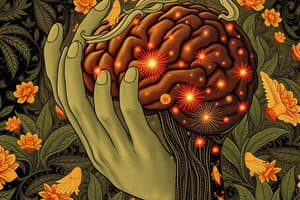Podcast
Questions and Answers
Which of the following is NOT a process involved in the Information Processing Model of Memory?
Which of the following is NOT a process involved in the Information Processing Model of Memory?
What is the duration of iconic memory, according to Sperling (1960)?
What is the duration of iconic memory, according to Sperling (1960)?
According to the Atkinson-Shiffrin Multi-Store Model of memory, what are the three main storage areas?
According to the Atkinson-Shiffrin Multi-Store Model of memory, what are the three main storage areas?
Which of the following is NOT a type of encoding?
Which of the following is NOT a type of encoding?
Signup and view all the answers
What is the primary role of attention in relation to memory encoding?
What is the primary role of attention in relation to memory encoding?
Signup and view all the answers
Which of the following is an example of how giving meaning to information can enhance memory encoding?
Which of the following is an example of how giving meaning to information can enhance memory encoding?
Signup and view all the answers
What does the term "consolidation" refer to in the context of memory?
What does the term "consolidation" refer to in the context of memory?
Signup and view all the answers
Which of the following statements accurately describes the relationship between memory and cognitive psychology?
Which of the following statements accurately describes the relationship between memory and cognitive psychology?
Signup and view all the answers
What is the main purpose of using mnemonics?
What is the main purpose of using mnemonics?
Signup and view all the answers
Which of the following is an example of an acrostic?
Which of the following is an example of an acrostic?
Signup and view all the answers
What does the method of loci utilize for memory improvement?
What does the method of loci utilize for memory improvement?
Signup and view all the answers
What distinguishes retrograde amnesia from anterograde amnesia?
What distinguishes retrograde amnesia from anterograde amnesia?
Signup and view all the answers
Which type of memory is NOT one of the three main storages of memory?
Which type of memory is NOT one of the three main storages of memory?
Signup and view all the answers
What defines procedural memory?
What defines procedural memory?
Signup and view all the answers
Which type of memory is primarily concerned with knowing facts and general knowledge?
Which type of memory is primarily concerned with knowing facts and general knowledge?
Signup and view all the answers
Which of the following is NOT a type of forgetting mentioned?
Which of the following is NOT a type of forgetting mentioned?
Signup and view all the answers
What is the term for the phenomenon when recent information interferes with the recall of older information?
What is the term for the phenomenon when recent information interferes with the recall of older information?
Signup and view all the answers
What type of amnesia did Henry Molaison experience after his brain surgery?
What type of amnesia did Henry Molaison experience after his brain surgery?
Signup and view all the answers
What is the process by which stored information is retrieved from memory called?
What is the process by which stored information is retrieved from memory called?
Signup and view all the answers
Which aspect of forgetting refers to memories that fade away over time?
Which aspect of forgetting refers to memories that fade away over time?
Signup and view all the answers
In terms of memory, what does episodic memory primarily involve?
In terms of memory, what does episodic memory primarily involve?
Signup and view all the answers
What is the typical capacity of short-term memory as proposed by Miller?
What is the typical capacity of short-term memory as proposed by Miller?
Signup and view all the answers
Which of the following best describes the concept of chunking?
Which of the following best describes the concept of chunking?
Signup and view all the answers
What is one of the components of Baddeley’s model of working memory?
What is one of the components of Baddeley’s model of working memory?
Signup and view all the answers
According to the serial position effect, which items are typically remembered best?
According to the serial position effect, which items are typically remembered best?
Signup and view all the answers
Which component of working memory is responsible for controlling other components and processing information?
Which component of working memory is responsible for controlling other components and processing information?
Signup and view all the answers
What type of information does the phonological loop process?
What type of information does the phonological loop process?
Signup and view all the answers
How does the recency effect contribute to the serial position effect?
How does the recency effect contribute to the serial position effect?
Signup and view all the answers
Which statement about the episodic buffer in working memory is accurate?
Which statement about the episodic buffer in working memory is accurate?
Signup and view all the answers
Study Notes
Lecture 6: Memory and Forgetting
- Learning Outcomes: Students should be able to identify different types of memory, explain forgetting, differentiate between anterograde and retrograde amnesia, and identify memory improvement strategies.
What is Memory?
- Memory is the retention of information.
- It's the ability to store and retrieve information.
- Memory is studied through cognitive psychology and cognitive neuroscience.
Memory Involves...
- Skills
- Facts that never change
- Facts that seldom or frequently change
Information Processing Model of Memory
- Memory processing has three stages: encoding, storage, and retrieval.
Encoding
- Encoding is the process of converting information into a usable form for storage.
- Three methods of encoding information are visual (picture), acoustic (sound), and semantic (meaning).
- Attention and emotional arousal enhance memory encoding.
- Giving meaning to information enhances memory.
Storage
- Storage is the process of maintaining or keeping information readily available.
- Memories are stored in short-term or long-term memory.
- The process of converting short-term to long-term memory is called consolidation.
Atkinson-Shiffrin Multi-Store Model
- Memory has three main storage areas: sensory, short-term, and long-term memory.
- Sensory memory has a duration of approximately one second, and information can be transferred to short-term memory by paying attention.
- Short-term memory has a limited capacity (7 ± 2 chunks) and information can be stored longer by rehearsal. Techniques like chunking support recall.
- Long-term memory stores information relatively permanently.
Sensory Memory
- Sensory memory is the shortest-term type and related to sensory input.
- Duration is roughly 1 second.
- Two types:
- Iconic memory (visual information, lasting about a quarter of a second).
- Echoic memory (auditory information, lasting about two seconds).
Short-Term Memory
- Short-term memory holds information currently being processed.
- Information is stored briefly and maintained through rehearsal.
- Short-term memory capacity is around 7 +/- 2 chunks.
- Chunking combines smaller pieces of information into larger, more manageable units.
Working Memory
- Working memory is an alternative model of short-term memory, involving active processing.
- Components include a central executive, phonological loop, visuospatial sketchpad, and episodic buffer.
- Baddeley and Hitch (1974) developed this.
Working Memory - Serial Position Effect
- We tend to remember items at the beginning of a list (primacy effect) and the end (recency effect). Mid-list items are often forgotten.
- Primacy and recency effects are because items at the beginning are better consolidated into long-term memory and items late in the list still reside in short-term memory.
Long-Term Memory
- Stores information relatively permanently.
- Duration is a lifetime.
- Stored based on meaning and importance.
- Two types:
- Declarative (explicit) memory: conscious about the information, such as knowing facts. Has two subdivisions:
- Semantic memory: general knowledge (e.g., capital of a country).
- Episodic memory: personal experiences (e.g., your birthday party).
- Procedural (implicit) memory: how to do something (e.g., ride a bike; drive).
- Declarative (explicit) memory: conscious about the information, such as knowing facts. Has two subdivisions:
Retrieval
- Retrieval is the process of recovering stored information from memory.
- This is akin to "remembering."
Forgetting
- Three elements to forgetting: transience (fading memories), absentmindedness (forgetting due to lack of attention), and blocking (difficulty retrieving stored information, such as tip-of-the-tongue).
- Forgetting is also influenced by retroactive/proactive interference (new/old information affecting recall respectively).
Forgetting Curve
- Ebbinghaus forgetting curve describes how information is lost over time. Loss is sharp initially but lessens thereafter.
Amnesia
- Organic amnesia results from brain damage.
- Two types:
- Anterograde amnesia: inability to remember new information after the damage.
- Retrograde amnesia: inability to remember information before the damage.
- Examples from case studies (e.g., HM).
- Brain regions (temporal lobe, hippocampus) play an important role in forming memories.
Memory Improvement Strategies
- Mnemonics are techniques to improve memory, including acronyms (initial letters make words), acrostics (word formed from first letters put into a sentence). Method of loci/journey method visualizes information in a familiar place.
Studying That Suits You
Use AI to generate personalized quizzes and flashcards to suit your learning preferences.
Related Documents
Description
Test your knowledge on the Information Processing Model of Memory and the Atkinson-Shiffrin Multi-Store Model. This quiz covers key concepts related to memory encoding, attention, and consolidation. Perfect for students studying cognitive psychology.




